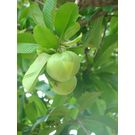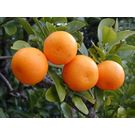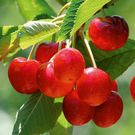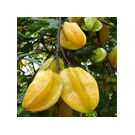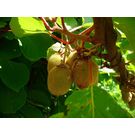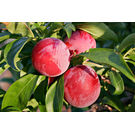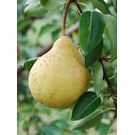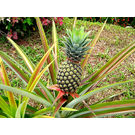Apple / Red Apple Fruit Plant

Description
Growing apple trees in the home garden can be fun and rewarding. Several factors are important to consider before planting for successful apple production. Apple variety and rootstock, site selection, proper planting, training and pruning, adequate fertility, and pest control all contribute to healthy and productive trees.
Pollination - All apple varieties should be considered self-incompatible, meaning that they cannot pollinate themselves or any flowers of the same apple variety. The highest quality fruit is harvested when cross-pollination occurs with a suitable pollinizer variety. You will need to plant at least two varieties of apple trees together in order to maximize fruit production and quality. Make sure that the varieties you choose have overlapping bloom dates, so that both varieties bloom at the same time. Some varieties, such as Winesap, Mutsu, Jonagold, and Stayman, produce sterile pollen and should never be used as pollinizers. However, pollen from other varieties can be used to pollinate these pollen-sterile varieties. Remember, two trees of the same apple variety cannot be used for cross-pollination. Since the pollen from apple blossoms is transferred primarily by bees, be careful not to spray insecticides during bloom when honey bees are present.
Soils - Take a soil test prior to planting your apple trees. Your local County Extension Center can instruct you in collecting the soil sample, help you interpret the results, and provide valuable information about the soil in your county. Results from the soil test will determine the soil amendments necessary to correct nutrient deficiencies and adjust soil pH. The amendments should be worked into the soil to a depth of 12 to 18 inches where the tree will root, not just the planting hole. Apple trees will tolerate a wide range of soils as long as water and nutrients are not limiting and soil pH is adequate. Avoid heavy, poorly-drained soils and low spots, since apple trees cannot survive if water remains standing in the root zone.
Air Drainage - It is important to select a site where the tree will not be in a "frost pocket", where cold air settles in low-lying areas. In a frost pocket, low spring temperatures commonly kill the blossoms or developing fruit because cold air settles around the tree. Good air drainage, especially during early spring frosts, is critical. Choose a higher site with a slope if possible so cold air will flow down away from the trees and will not accumulate around the trees. Do not plant the trees close to a fence row, wooded area, or at the bottom of a hill, as cold air drainage will be impeded.
Other Considerations - Apple trees require full sun and should be planted where the trees will not be shaded from large trees or buildings. Follow tree spacing guidelines that pertain to the rootstock you have chosen from Table 1. Do not plant trees near wooded areas or streams to avoid animal damage. Prior to planting, remove weeds either manually or with an approved herbicide that will not harm the young tree. If you are planting the tree in a lawn, remove the grass from the planting area in a 4-foot diameter circle. Grass competes with young trees for available water and nutrients and can significantly reduce tree growth and productivity.
Planting the Tree - Apple trees can be set from late fall to early spring. To plant the apple tree, first dig a hole approximately twice the diameter of the root system and 2 feet deep. Place some of the loose soil back into the hole and loosen the soil on the walls of the planting hole so the roots can easily penetrate the soil. Spread the tree roots on the loose soil, making sure they are not twisted or crowded in the hole. Continue to replace soil around the roots. As you begin to cover the roots, firm the soil to be sure it surrounds the roots and to remove air pockets. Do not add fertilizer at planting time as the roots can be "burned". Fill the remainder of the hole with the loose soil, and press the soil down well. Important: The graft union must be at least 2 inches above the soil line so that roots do not emerge from the scion. When you have finished planting the tree, water well to eliminate air pockets and provide good contact between the roots and the soil.
Apples reach maturity at different times, depending on variety and climate. There is not a specific date at which you can expect to harvest your apples. Instead, you can observe your apples as they grow and inspect the fruit for certain changes which indicate maturity. The "ground" or base skin color of the apples changes from green to yellow as the fruit matures. Flesh color also loses its greenish tint and turns yellow or white. When you are convinced that the apples look mature, take a bite! A mature fruit will be crisp and juicy. A pleasing taste is the final indicator of fruit maturity.
Proper storage conditions help prolong the shelf-life of your apples. Store apples at 32 oF and maintain high humidity. The crisper drawers of many refrigerators work well, but keep the fruit away from vegetables since ripening fruit gives off gas that may spoil vegetables. Apples can also be stored in plastic bags in the refrigerator to prevent fruit dehydration.
You may also be interested in
Look for Similar Items by Category
- Home > Fruit Plants > Apple


